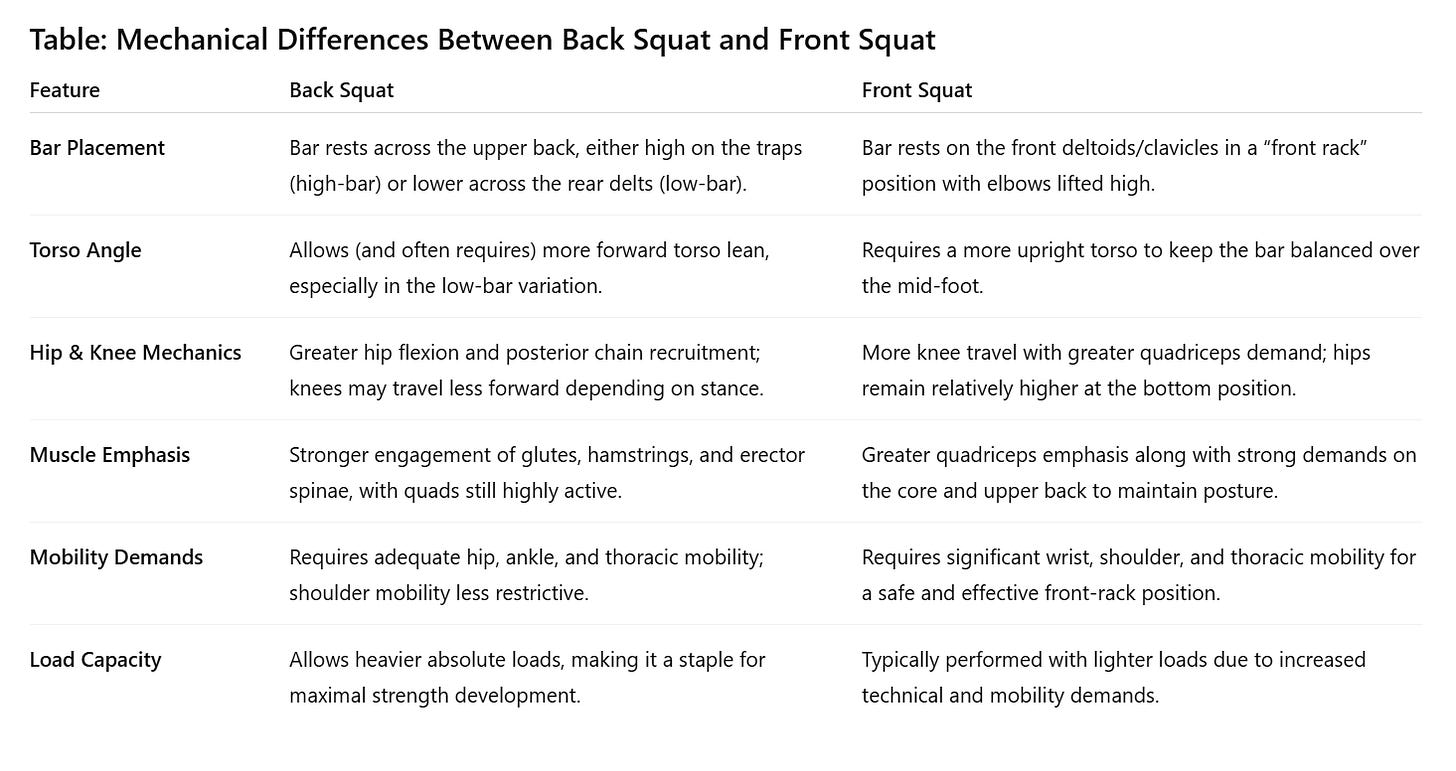Front Squat vs. Back Squat: Which is Better?
Different movements with different benefits
There are so many movements we can do to target just about any area of fitness, and it seems like every week, there are new movements that are trending. Squats are no different. There are many ways to do squats and then duplicate that by adding dumbbells as an alternative to the barbell.
So let’s just take 2 types of squats - the front squat and the back squat. Which is better? It depends. These two types of squats vary significantly in mechanics and muscle activation.
Today, we’ll be comparing the two so that you can decide how best to integrate these movements to reach your fitness goals and to accommodate any fitness limitations or injuries.
Movement Mechanics
To see these movements in action, check out the linked video demos of the Front Squat and Back Squat.
Below is a table that summarizes the differences in movement mechanics between the Front and Back squats. Here are the key takeaways:
Back strain: Back squat: More forward lean/strain on the lower back. Front squat: Requires a more upright position and targets the upper back and core.
Target muscles: Back squats: Greater focus on glutes, hamstrings, and spinal erectors. Front squat: Greater emphasis on quadriceps, core, and upper back. Both movements target quadriceps activation.
Mobility: Back squats: Requires greater hip, ankle, and thoracic mobility. Front squats: Require greater wrist, shoulder, and thoracic mobility to maintain the front rack position of the bar. Both movements require knee mobility, with the front squat loading more toward the knees with greater forward tracking of the knees in the front squat.
References
The Barbell. Front Squat vs Back Squat: Key Differences. Retrieved from thebarbell.com.
Powerlifting Technique. Front Squat vs Back Squat: Differences, Pros & Cons. Retrieved from powerliftingtechnique.com.
Garage Gym Reviews. Front Squat vs Back Squat. Retrieved from garagegymreviews.com.
BarBend. Front Squat vs Back Squat: Biomechanics and Benefits. Retrieved from barbend.com
Which is better? - It depends on your goal
Studies comparing these two types of squat in older adults is scant at best. What we know about these two squats compared head-to-head comes from studies of males and younger females, from recreational to athletically trained. Although having data in the female age 40+ population would be ideal, we can still glean some helpful information from the studies that exist:
Greater load and overall lower-body strength is achieved best with the back squat.
Quadriceps hypertrophy and knee-dominant work is best achieved with the front squat.
If one has lower back concerns, the front squat is the better option
For more balanced lower body development targeting the glutes, hamstrings, quadriceps and posterior chain, the back squat is best.
If mobility is limited in the wrist, shoulders, thoracic area, and/or ankles, progressions starting with the back squat is suggested, adding the front squat once greater strength and mobility is achieved.
MOBILITY TIP! Moving within your pain-free range of motion is important for staying safe and for creating a base for progression and improvement of your range of motion. Squatting to a target, such as a chair, bench, medball or other target is a great way to find your range limit. As you get stronger and more proficient, you can safely lower the target, increasing that pain-free range.
What we DO know in the older population, and is apparent peer-reviewed studies, is that squat training, in general, improves functional strength and performance in activities of daily living.
Warm Up
3 Rounds
10 Up downs
10 weighted Good Mornings
(use a dumbbell/plate held at the chest or a barbell in the back rack position)
10 air squats
Movement Practice
Take 5-10 minutes to select your weights/options for the workout.
For the front squat, select a weight that allows you to achieve 5-10 repetitions for each movement during the 30-second work interval.
Practice the kettlebell swing, first with a light kettlebell, then select the weight. Select a weight where you can do 7-10 repetitions unbroken during the warm-up. Then, test your swing. The first movement option is a swing to eye-level (“Russian swing”). A more advanced option for those proficient with the kettlebell swing and healthy shoulders is the swing to overhead (“American swing”). Choose which works best for you!
Movement alternatives:
Double dumbbell swing if no kettlebell
Dumbbell front squat if no barbell
Workout
There are two potential strategies for this workout. You can do a heavier weight for fewer repetitions, or a lighter weight for more repetitions. Your score is influenced by BOTH your weight and the number of repetitionsY that you are able to achieve. Have fun with this!
10 Rounds
:30 Rest
:30 Rest
Your Score: TOTAL REPETITIONS x TOTAL WEIGHT (Kettlebell + Front squat)
Cool-Down
7 minute static back and hip stretch sequence from Train for the Win (TFW)
NOW TAKING NEW CLIENTS!
If you are an active woman or competitive midlife athlete who feels abandoned by mainstream medicine, I’m here for you!
It is with great excitement that after more than 2 years of preparation, I have FINALLY launched my Telehealth Consultation Medical practice focusing on the Reproductive Endocrine needs and Menopausal Care for active, athletic, and high-performing women.
Active and athletic midlife women have needs and risk profiles that are different from the general population. These needs often go unmet by the mainstream medical community due to a lack of understanding of fitness and sport and their impact on mid-life hormonal physiology or even a lack of acknowledgment that this dynamic exists. We put your health, fitness, and performance at the center of the equation so that you can achieve your healthiest, highest-performing self!
You will find all my service offerings on my website including a link to my calendar so that you can reserve your place in my schedule!





Back Squat is my favorite, but I do like the front squat for the challenge. My wrist strength has gotten a lot better because of front squats.